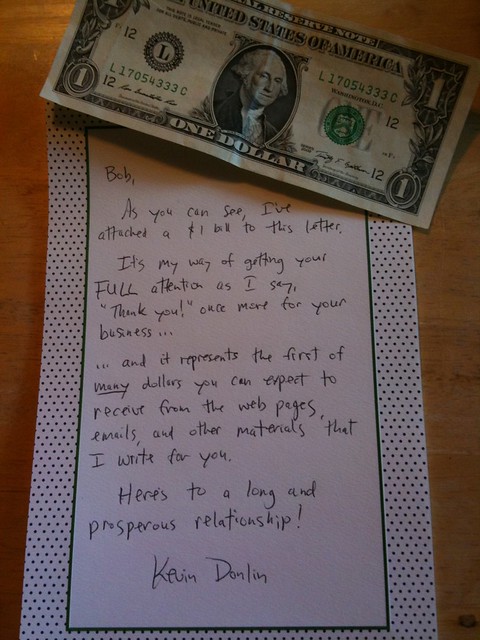Here's a story I've never told anyone before ...
Six years ago, I accidentally created a business that put $2,159,342.40 in my bank account.
How did I do it?
By focusing the vast majority of my marketing efforts on the vital few activities that made the most profits.
After I made this 80/20 shift in thinking (which I explain below), revenue surged, like this ...
Specifically, revenue jumped from $1,109 in May 2005 to $7,808 in July ...
... to $51,856 in September 2005 and kept climbing to $110,945 one year later, in September 2006.
More than $2,159,342 flooded into my business in 5 years, before all was said and done.
Here are 5 years of revenue totals from this project:
- $244,504.16 (2005)
- $640,471.97 (2006)
- $618,848.09 (2007)
- $465,132.78 (2008)
- $166,109.56 (2009)
Where did this money come from?
I promoted programs for companies that paid a couple bucks for every lead I sent to their web site using Google AdWords.
I can't be more specific than that, but I can tell you the bulk of that $2.1 million came from a
single Google AdWords ad that I honed, improved, polished, perfected, and rolled out to multiple markets in North America.
Google will come to my house and stick my dog's head down the toilet if I tell you any more ...
... but I can tell you about the process that helped me make a $2.1-million killing.
I combined the 80/20 Rule with Marketing 101 to create a new concept (new for me, anyway) that you can use, too.
I call it
80/20 Marketing.
Because you should already understand Marketing 101, let's define the 80/20 Rule.
You may also know it as the Pareto Principle, named after Italian economist Vilfredo Pareto, who observed in 1906 that 80% of the property in Italy was owned by 20% of the people.
Stated differently, 20% of causes account for about 80% results, and 80% of causes produce about 20% of results. The world is unbalanced and unequal -- predictably so.
The 80/20 Rule is a spooky natural law that doesn’t make any logical sense:
- 20% of clouds produce 80% of rain ...
- 20% of U.S. states produce 80% of home foreclosures, and ...
- you wear 20% of your shirts 80% of the time (especially if you're a guy!)
Note: The ratio is rarely 80/20 exactly -- it may be 72/17 ... 88/11 ... 75/6 ... etc. But the numbers are always unbalanced.
In any business, including yours, about:
- 80% of sales come from 20% of products or services
- 80% of complaints come from 20% of customers
- 80% of profits come from 20% of marketing activities
This last area is important -- marketing.
Because marketing is one of the vital few things you do that really matters in business -- it's a 20% Activity that produces outsized results.
One day, in May 2005, I thought: "What if I were to apply the 80/20 Rule to marketing, and do only those things that really made me money, dropping, delegating, or streamlining the rest? What would happen?"
More than $2.1 million happened, that's what.
Let me share one of the success secrets I found after months of trial and error ....
In a word, it's
replacement.
You see, after I uncovered certain elements of my marketing that were producing small, but disproportionately large profits, I replaced 80% activities (the majority of marketing that was largely a waste of time) with 20% activities (those few things that produced disproportionately big results).
In the months that followed, I turned my business upside down and devoted EVERY WAKING HOUR to writing, testing, and improving the Google AdWords ads that produced unexpectedly high revenue. (Important: You do NOT need to use Google Adwords or even know what they are to profit from this idea -- you simply need to find just one small, repeatable success to exploit fully.)
Some days I worked 12 hours and had nothing to show. Other days, a 15-minute effort added $25 a day in revenue. Smart, focused work produced small, continuous, profitable improvements.
Now. You may think: "Where do I find time for another marketing system?" or "I'm not the boss -- I can't change our business model to do this."
Both excuses are invalid. Because you have plenty of time -- you're just misusing 80% of it. And 80/20 Marketing works for any business model, by refining and ramping up whatever success you're having now.
Here are just two of the many ways I found time to devote to engage in 80/20 Marketing:
- closed down an entire business (it was time-intensive and no longer fun).
- stopped checking email more than once a day (a game-changer that freed up 2-3 hours daily).
Results were fast in coming ...
I increased annual revenue from this project by 10 TIMES, from $24,587 in 2004, to $244,504 in 2005. Then I TRIPLED IT, to $640,471 in 2006. The rest is history.
I now teach a
4-week course on 80/20 Marketing that is changing lives for entrepreneurs.
Whether or not an extra $2.1 million in high-net revenue excites you, the principles of 80/20 Marketing should.
Simply put, most of what you do to market your business doesn't matter. Only a few things do. Do more of them, and your life can improve dramatically, rapidly, and predictably.
Bio: Kevin Donlin can help you grow your business and enjoy the breakthrough results your hard work deserves. If you're interested in boosting your revenues and profits,
please click here.












